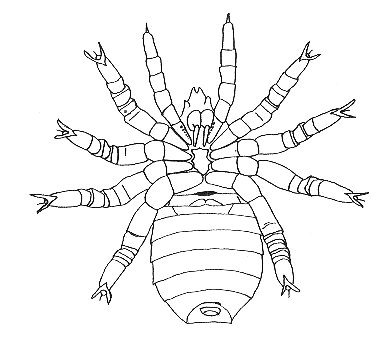

Reconstructions of Palaeocharinus rhyniensis by Dr. Jason Dunlop,
Berlin
Click
here to
see the impressive 3-D reconstruction by Dr. Dunlop.
Trigonotarbids: spider-like animals |
| The trigonotarbids are an extinct order within the spider-like animals
(Arachnida) and they are related to the modern spiders without being real
spiders. They existed from the late Silurian till in the Early Permian.
Maiocercus celticus from the Late
Carboniferous of Ibbenbüren also belongs to this group. They are well
preserved in the Rhynie chert, as becomes clear from the photos. Sometimes
even the booklungs have been preserved. The differences with real spiders are as follows: - trigonotarbids didn't have spinnerets - trigonotarbids were in the possession of a segmented exoskeleton around the abdomen - trigonotarbids had median eyes and lateral eyes placed on separate tubercles (and not on one tubercle like the real spiders). The body is composed of a head region (prosoma) and an abdomen (opisthosoma). Remains of trigonotarbids are easily recognized by the scale-like structure of the plates. The presence of setae (flexible hairs) in the mouth region is also characteristic for this group. Five species have been described in the past but probably only two of them are valid, of which Palaeocharinus rhyniensis is the most common one. Recently a third species has been described. Go for an extensive description of this genus to the website of the University of Aberdeen. |
Reconstructions of Palaeocharinus rhyniensis by Dr. Jason Dunlop,
Berlin |
Transverse section and abdomen Head with mouth parts, and a walking leg Distal part of a leg with a claw Part of the abdomen with ornamentation |